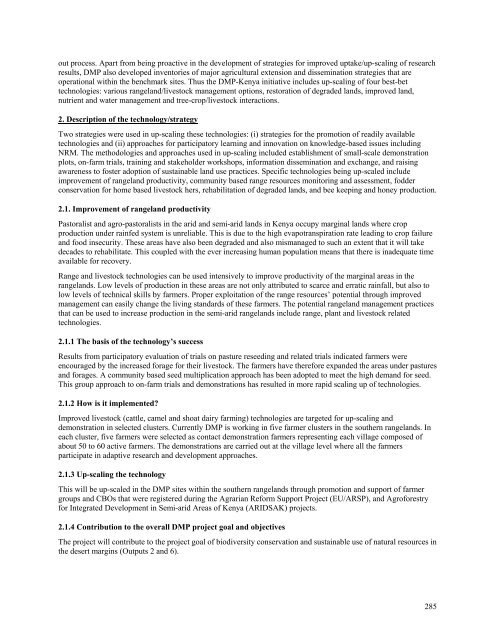ICRISAT Archival Report 2006 - The seedlings of success in the ...
ICRISAT Archival Report 2006 - The seedlings of success in the ...
ICRISAT Archival Report 2006 - The seedlings of success in the ...
You also want an ePaper? Increase the reach of your titles
YUMPU automatically turns print PDFs into web optimized ePapers that Google loves.
out process. Apart from be<strong>in</strong>g proactive <strong>in</strong> <strong>the</strong> development <strong>of</strong> strategies for improved uptake/up-scal<strong>in</strong>g <strong>of</strong> research<br />
results, DMP also developed <strong>in</strong>ventories <strong>of</strong> major agricultural extension and dissem<strong>in</strong>ation strategies that are<br />
operational with<strong>in</strong> <strong>the</strong> benchmark sites. Thus <strong>the</strong> DMP-Kenya <strong>in</strong>itiative <strong>in</strong>cludes up-scal<strong>in</strong>g <strong>of</strong> four best-bet<br />
technologies: various rangeland/livestock management options, restoration <strong>of</strong> degraded lands, improved land,<br />
nutrient and water management and tree-crop/livestock <strong>in</strong>teractions.<br />
2. Description <strong>of</strong> <strong>the</strong> technology/strategy<br />
Two strategies were used <strong>in</strong> up-scal<strong>in</strong>g <strong>the</strong>se technologies: (i) strategies for <strong>the</strong> promotion <strong>of</strong> readily available<br />
technologies and (ii) approaches for participatory learn<strong>in</strong>g and <strong>in</strong>novation on knowledge-based issues <strong>in</strong>clud<strong>in</strong>g<br />
NRM. <strong>The</strong> methodologies and approaches used <strong>in</strong> up-scal<strong>in</strong>g <strong>in</strong>cluded establishment <strong>of</strong> small-scale demonstration<br />
plots, on-farm trials, tra<strong>in</strong><strong>in</strong>g and stakeholder workshops, <strong>in</strong>formation dissem<strong>in</strong>ation and exchange, and rais<strong>in</strong>g<br />
awareness to foster adoption <strong>of</strong> susta<strong>in</strong>able land use practices. Specific technologies be<strong>in</strong>g up-scaled <strong>in</strong>clude<br />
improvement <strong>of</strong> rangeland productivity, community based range resources monitor<strong>in</strong>g and assessment, fodder<br />
conservation for home based livestock hers, rehabilitation <strong>of</strong> degraded lands, and bee keep<strong>in</strong>g and honey production.<br />
2.1. Improvement <strong>of</strong> rangeland productivity<br />
Pastoralist and agro-pastoralists <strong>in</strong> <strong>the</strong> arid and semi-arid lands <strong>in</strong> Kenya occupy marg<strong>in</strong>al lands where crop<br />
production under ra<strong>in</strong>fed system is unreliable. This is due to <strong>the</strong> high evapotranspiration rate lead<strong>in</strong>g to crop failure<br />
and food <strong>in</strong>security. <strong>The</strong>se areas have also been degraded and also mismanaged to such an extent that it will take<br />
decades to rehabilitate. This coupled with <strong>the</strong> ever <strong>in</strong>creas<strong>in</strong>g human population means that <strong>the</strong>re is <strong>in</strong>adequate time<br />
available for recovery.<br />
Range and livestock technologies can be used <strong>in</strong>tensively to improve productivity <strong>of</strong> <strong>the</strong> marg<strong>in</strong>al areas <strong>in</strong> <strong>the</strong><br />
rangelands. Low levels <strong>of</strong> production <strong>in</strong> <strong>the</strong>se areas are not only attributed to scarce and erratic ra<strong>in</strong>fall, but also to<br />
low levels <strong>of</strong> technical skills by farmers. Proper exploitation <strong>of</strong> <strong>the</strong> range resources’ potential through improved<br />
management can easily change <strong>the</strong> liv<strong>in</strong>g standards <strong>of</strong> <strong>the</strong>se farmers. <strong>The</strong> potential rangeland management practices<br />
that can be used to <strong>in</strong>crease production <strong>in</strong> <strong>the</strong> semi-arid rangelands <strong>in</strong>clude range, plant and livestock related<br />
technologies.<br />
2.1.1 <strong>The</strong> basis <strong>of</strong> <strong>the</strong> technology’s <strong>success</strong><br />
Results from participatory evaluation <strong>of</strong> trials on pasture reseed<strong>in</strong>g and related trials <strong>in</strong>dicated farmers were<br />
encouraged by <strong>the</strong> <strong>in</strong>creased forage for <strong>the</strong>ir livestock. <strong>The</strong> farmers have <strong>the</strong>refore expanded <strong>the</strong> areas under pastures<br />
and forages. A community based seed multiplication approach has been adopted to meet <strong>the</strong> high demand for seed.<br />
This group approach to on-farm trials and demonstrations has resulted <strong>in</strong> more rapid scal<strong>in</strong>g up <strong>of</strong> technologies.<br />
2.1.2 How is it implemented?<br />
Improved livestock (cattle, camel and shoat dairy farm<strong>in</strong>g) technologies are targeted for up-scal<strong>in</strong>g and<br />
demonstration <strong>in</strong> selected clusters. Currently DMP is work<strong>in</strong>g <strong>in</strong> five farmer clusters <strong>in</strong> <strong>the</strong> sou<strong>the</strong>rn rangelands. In<br />
each cluster, five farmers were selected as contact demonstration farmers represent<strong>in</strong>g each village composed <strong>of</strong><br />
about 50 to 60 active farmers. <strong>The</strong> demonstrations are carried out at <strong>the</strong> village level where all <strong>the</strong> farmers<br />
participate <strong>in</strong> adaptive research and development approaches.<br />
2.1.3 Up-scal<strong>in</strong>g <strong>the</strong> technology<br />
This will be up-scaled <strong>in</strong> <strong>the</strong> DMP sites with<strong>in</strong> <strong>the</strong> sou<strong>the</strong>rn rangelands through promotion and support <strong>of</strong> farmer<br />
groups and CBOs that were registered dur<strong>in</strong>g <strong>the</strong> Agrarian Reform Support Project (EU/ARSP), and Agr<strong>of</strong>orestry<br />
for Integrated Development <strong>in</strong> Semi-arid Areas <strong>of</strong> Kenya (ARIDSAK) projects.<br />
2.1.4 Contribution to <strong>the</strong> overall DMP project goal and objectives<br />
<strong>The</strong> project will contribute to <strong>the</strong> project goal <strong>of</strong> biodiversity conservation and susta<strong>in</strong>able use <strong>of</strong> natural resources <strong>in</strong><br />
<strong>the</strong> desert marg<strong>in</strong>s (Outputs 2 and 6).<br />
285

















